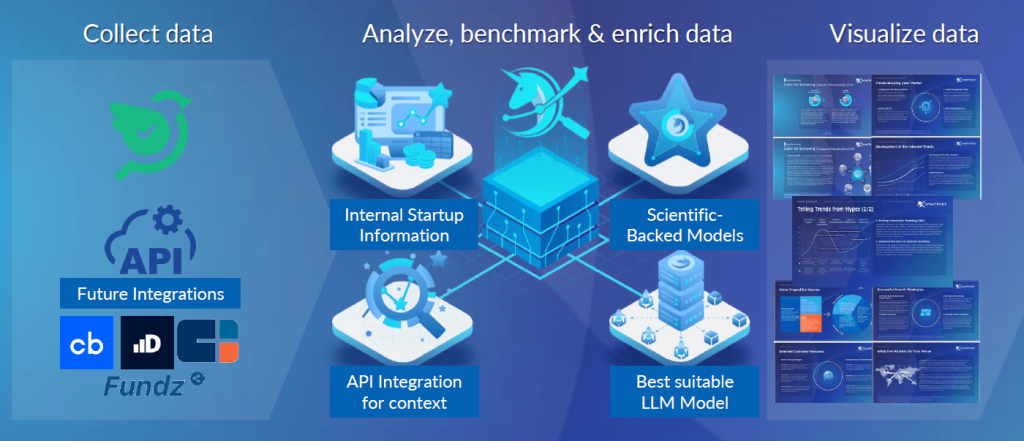How to Conduct Market Research for a New Business: A Step-by-Step Guide

Starting a new business without market research is like sailing without a map. The risk of failure increases exponentially when you rely on assumptions instead of actual market signals. The good news? Market research isn’t just for big corporations or well-funded startups. With the right approach—and the right tools—you can gain the insights needed to validate your idea, understand your audience, and plan for growth in a matter of hours.
In this in-depth guide, we break down a practical, repeatable framework for conducting market research that fuels real-world traction. Whether you’re launching a new startup, testing a product within an existing company, or exploring market entry opportunities, this step-by-step process will help you make smarter, data-driven decisions. And throughout this guide, we’ll show how GrowthTrust supports every stage of market research with AI-powered insights, expert-reviewed outputs, and strategic clarity—delivered faster than ever before.
Why Market Research Is Essential for New Businesses
Most startups fail—not from lack of effort, but from building solutions for problems that don’t really exist.
Market research helps you:
Avoid wasted development cycles
Uncover unmet customer needs
Position your product clearly against competitors
Justify decisions with evidence (not opinions)
It transforms your idea into a validated hypothesis and your plan into a strategic roadmap. With a tool like GrowthTrust, early-stage teams can accelerate this process—running full market assessments in 24–48 hours, instead of spending weeks scraping together assumptions.
Types of Market Research: Primary vs. Secondary
Understanding the two core types of market research helps shape your approach.
Primary Research
You gather insights directly from your audience:
Interviews
Surveys
Usability tests
Observation
Best for: uncovering specific needs, behavior patterns, or emotional drivers.
Secondary Research
You analyze information collected by others:
Industry reports
Databases (e.g., CB Insights, Statista)
Competitor websites
Public funding or patent filings
Best for: trend identification, market sizing, and landscape scanning.
How GrowthTrust Bridges Both
GrowthTrust pulls verified secondary data (market trends, customer insights, competitor profiles) into an easy-to-read analysis. It also includes frameworks like persona matching and strategic fit scoring to simulate the outcomes of primary research—without needing to interview 100 customers.
How to Conduct Market Research
Step-by-step market research process for startups
Step 1: Define Your Market Research Objective
Before diving in, clarify what you’re trying to learn. Focused research leads to focused insights.
Common Objectives:
“Is there real demand for this idea?”
“Who are our ideal customers?”
“Which market segments show the most potential?”
“What are the current competitors doing?”
Don’t research everything at once. Choose 1–2 core questions to answer, then iterate.
Step 2: Identify Your Target Audience
You can’t serve everyone. Research becomes powerful when you define exactly who you’re trying to reach.
Key Attributes to Define:
Demographics: Age, location, income, job title
Firmographics (B2B): Industry, company size, buying roles
Behaviors: Pain points, workflows, tech adoption, buying triggers
Psychographics: Motivations, beliefs, risk tolerance
GrowthTrust automatically builds persona maps using real-time job roles, company info, and behavior patterns—so you don’t need to guess which segment to go after.
Step 3: Analyze Competitors
Competitor analysis reveals what’s already working—and where you can stand out.
What to Look For:
Positioning language (What problem do they claim to solve?)
Product features & pricing
Market traction (Funding, team size, partnerships)
SEO/traffic trends
Gaps in audience focus or regions served
GrowthTrust’s Competitive Intelligence Engine scans your sector for direct and adjacent competitors, delivering side-by-side comparisons and a strategic positioning map—within minutes.
Step 4: Explore Market Size, Demand & Trends
Questions to Answer:
What’s the TAM/SAM/SOM for this product?
Is demand growing or shrinking in this segment?
What macro trends (tech, regulation, behavior) will impact this market?
This is where GrowthTrust shines—automatically pulling market sizing models, growth projections, and regulatory scans from thousands of data points, so you know where the opportunity lies.
Step 5: Run Customer Discovery
If you’re early-stage, a few conversations go a long way. Talk to potential customers to hear what they say—and what they don’t say.
How to Do It:
Ask open-ended questions: “Tell me about how you currently solve [problem]?”
Avoid pitching—just listen
Ask follow-ups: “What would make that process easier?”
Record patterns, not just quotes
Don’t want to do 25 interviews? GrowthTrust simulates persona insights by aggregating relevant sentiment, behavior, and needs across roles and markets—reducing the need for long discovery cycles.
Step 6: Validate with Real-Time Market Data
Once you’ve done the basics, you need validation. That means checking your assumptions against real, dynamic data—not outdated slides.
With GrowthTrust, you can:
Run a 24-hour market assessment using your idea or industry focus
Get insights on market size, competitors, trends, and customer types
Export an investor-ready summary to validate decisions
You can also request expert review to ensure accuracy before pitching or planning execution.
Step 7: Turn Research into Strategy
Good research only matters if it turns into action.
Take your findings and feed them into:
Your product roadmap
Your go-to-market strategy
Your fundraising narrative
Your internal alignment decks
GrowthTrust includes built-in strategic frameworks like SWOT, PESTLE, and strategic positioning maps to help you turn insight into clarity—then into execution.
Common Pitfalls and How to Avoid Them
Mistake #1: Researching too broadly
Fix: Start with one key goal. Expand only as needed.
Mistake #2: Relying only on friends or peers
Fix: Talk to actual target customers or simulate via data.
Mistake #3: Skipping competitive analysis
Fix: Always understand who else is in the space.
Mistake #4: No next steps
Fix: Convert research into a strategy and share it with your team.
How GrowthTrust Makes Market Research Smarter
GrowthTrust was built to give founders, corporate teams, and investors clarity at startup speed.
With tokens, you can:
Run a market scan in under 48 hours
Identify the most promising segments
Validate product direction with PMF scoring
Get expert-reviewed strategy templates
Export board- and investor-ready reports
It’s everything you’d get from a research agency—without the cost, delay, or overwhelm.

From Insight to Execution
Market research isn’t just a checkbox—it’s the foundation of a high-conviction business. The fastest-growing teams don’t guess their way to success. They gather signals early, validate what works, and adjust before spending months building the wrong thing.
With GrowthTrust, you’re not just doing market research. You’re making strategy smarter, faster, and more actionable from day one. Start your free assessment or request a GrowthTrust demo today.
